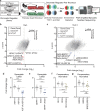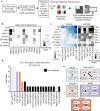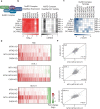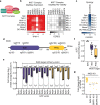Chromatin complex dependencies reveal targeting opportunities in leukemia
- PMID: 36707513
- PMCID: PMC9883437
- DOI: 10.1038/s41467-023-36150-7
Chromatin complex dependencies reveal targeting opportunities in leukemia
Abstract
Chromatin regulators are frequently mutated in human cancer and are attractive drug targets. They include diverse proteins that share functional domains and assemble into related multi-subunit complexes. To investigate functional relationships among these regulators, here we apply combinatorial CRISPR knockouts (KOs) to test over 35,000 gene-gene pairings in leukemia cells, using a library of over 300,000 constructs. Top pairs that demonstrate either compensatory non-lethal interactions or synergistic lethality enrich for paralogs and targets that occupy the same protein complex. The screen highlights protein complex dependencies not apparent in single KO screens, for example MCM histone exchange, the nucleosome remodeling and deacetylase (NuRD) complex, and HBO1 (KAT7) complex. We explore two approaches to NuRD complex inactivation. Paralog and non-paralog combinations of the KAT7 complex emerge as synergistic lethal and specifically nominate the ING5 PHD domain as a potential therapeutic target when paired with other KAT7 complex member losses. These findings highlight the power of combinatorial screening to provide mechanistic insight and identify therapeutic targets within redundant networks.
© 2023. The Author(s).
Conflict of interest statement
B.E.B. declares outside interests in Fulcrum Therapeutics, HiFiBio, Arsenal Biosciences, Cell Signaling Technologies, Chroma Medicine, and Design Pharmaceuticals. J.G.D. consults for Microsoft Research, Abata Therapeutics, Servier, Maze Therapeutics, BioNTech, Sangamo, and Pfizer. J.G.D. consults for and has equity in Tango Therapeutics. J.G.D. serves as a paid scientific advisor to the Laboratory for Genomics Research, funded in part by GlaxoSmithKline. J.G.D. receives funding support from the Functional Genomics Consortium: Abbvie, Bristol Myers Squibb, Janssen, Merck, and Vir Biotechnology. J.G.D.’s interests were reviewed and are managed by the Broad Institute in accordance with its conflict of interest policies. All other authors declare no competing interests.
Figures




Similar articles
-
Collateral lethality between HDAC1 and HDAC2 exploits cancer-specific NuRD complex vulnerabilities.Nat Struct Mol Biol. 2023 Aug;30(8):1160-1171. doi: 10.1038/s41594-023-01041-4. Epub 2023 Jul 24. Nat Struct Mol Biol. 2023. PMID: 37488358 Free PMC article.
-
Harnessing of the nucleosome-remodeling-deacetylase complex controls lymphocyte development and prevents leukemogenesis.Nat Immunol. 2011 Nov 13;13(1):86-94. doi: 10.1038/ni.2150. Nat Immunol. 2011. PMID: 22080921 Free PMC article.
-
Mi-2/NuRD chromatin remodeling complexes regulate B and T-lymphocyte development and function.Immunol Rev. 2014 Sep;261(1):126-40. doi: 10.1111/imr.12209. Immunol Rev. 2014. PMID: 25123281 Free PMC article. Review.
-
Structural basis of plant homeodomain finger 6 (PHF6) recognition by the retinoblastoma binding protein 4 (RBBP4) component of the nucleosome remodeling and deacetylase (NuRD) complex.J Biol Chem. 2015 Mar 6;290(10):6630-8. doi: 10.1074/jbc.M114.610196. Epub 2015 Jan 19. J Biol Chem. 2015. PMID: 25601084 Free PMC article.
-
Dangerous liaisons: interplay between SWI/SNF, NuRD, and Polycomb in chromatin regulation and cancer.Genes Dev. 2019 Aug 1;33(15-16):936-959. doi: 10.1101/gad.326066.119. Epub 2019 May 23. Genes Dev. 2019. PMID: 31123059 Free PMC article. Review.
Cited by
-
Nucleosome repositioning in chronic lymphocytic leukemia.Genome Res. 2023 Oct;33(10):1649-1661. doi: 10.1101/gr.277298.122. Epub 2023 Sep 12. Genome Res. 2023. PMID: 37699659 Free PMC article.
-
Pharmacological targeting of the cancer epigenome.Nat Cancer. 2024 Jun;5(6):844-865. doi: 10.1038/s43018-024-00777-2. Epub 2024 Jun 27. Nat Cancer. 2024. PMID: 38937652 Free PMC article. Review.
-
Knockout of the ING5 epigenetic regulator confirms roles in stem cell maintenance and tumor suppression in vivo.PLoS One. 2025 Jan 9;20(1):e0313255. doi: 10.1371/journal.pone.0313255. eCollection 2025. PLoS One. 2025. PMID: 39787145 Free PMC article.
-
Multi-locus CRISPRi targeting with a single truncated guide RNA.Nat Commun. 2025 Feb 4;16(1):1357. doi: 10.1038/s41467-025-56144-x. Nat Commun. 2025. PMID: 39905017 Free PMC article.
-
Requirement of WDR70 for POLE3-mediated DNA double-strand breaks repair.Sci Adv. 2023 Sep 8;9(36):eadh2358. doi: 10.1126/sciadv.adh2358. Epub 2023 Sep 8. Sci Adv. 2023. PMID: 37682991 Free PMC article.
References
-
- Allis CD, Jenuwein T. The molecular hallmarks of epigenetic control. Nat. Rev. Genet. 2016;17:487–500. - PubMed
-
- Lawrence M, Daujat S, Schneider R. Lateral thinking: how histone modifications regulate gene expression. Trends Genet. 2016;32:42–56. - PubMed
-
- Stadhouders R, Filion GJ, Graf T. Transcription factors and 3D genome conformation in cell-fate decisions. Nature. 2019;569:345–354. - PubMed
Publication types
MeSH terms
Substances
Grants and funding
LinkOut - more resources
Full Text Sources
Medical
Molecular Biology Databases
Research Materials

